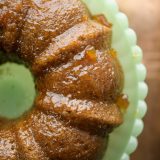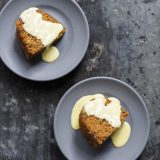The pudding began as a rather humdrum but eminently practical culinary invention. During the Middle Ages, boiling was often the cooking method of choice. And stuffed foods—using one of nature’s handy containers, such as the stomach (think haggis) or intestines—were an easy next step.
By the 17th century, the pudding cloth, suet pastry and molds came into play. These early puddings were savory, not sweet, as in pease pudding (boiled dried peas); hackin pudding (veal, oats, suet, spices); and blancmange, which contained chicken as well as rice, almonds and milk.
As sugar became cheaper and more available, puddings headed to the dessert trolley including plum duff, dead man’s arm (a roly poly cooked in a shirtsleeve), Sussex Pond (apples), Bakewell (a puff pastry custard tart), trifle, flummery and, of course, spotted dick (which makes Americans snigger, but “dick” is simply another word for dough). Puddings soon showed up in Beatrix Potter—Tom Kitten is captured by the attic rats and became the filling for a roly poly before his timely rescue.
I was introduced to the notion of steamed marmalade pudding by a good friend, Andrea Geary, who had been the pastry chef at the Kinloch Lodge on Scotland's Isle of Skye, and who extolled the many virtues of this dessert. We found a recipe from The Three Chimneys restaurant, also on Skye, which called for breadcrumbs, brown sugar, wholemeal flour, eggs, melted butter, baking soda and, of course coarse—cut Seville orange marmalade.
This is a simple recipe—whisk, dump and stir—and it cooks on top of the stove in a “three-pint pudding basin” set into a large pot with water reaching halfway up the side. The pudding was eminently practical since no oven was needed and only a modest amount of energy was required to keep a small quantity of water at a simmer. (You can also check the pudding easily without having to haul it in and out of the oven.)
The first problem was the lack of a pudding basin or bowl. A Bundt pan appealed but making it work on top of the stove was a non-starter given its size and shape. A 350°F oven, however, worked just fine, setting the Bundt pan covered with foil into a roasting pan filled halfway with water. (If you had the right equipment, however, you could make this recipe on the stovetop.)
Most of the ingredients were similar, including the whole-wheat bread for breadcrumbs, but we used more eggs for a lighter texture and added additional flavorings: vanilla, crystallized ginger, nutmeg and orange zest. Buttering the pan, then coating it with some of the dry breadcrumbs solved the problem of sticking. And we found that processing some of the marmalade with the crystallized ginger prevented the chunks from settling to the bottom during baking. Finally, we made a boozy sauce with whiskey (of course), as well as both fresh and crystallized ginger.
I am quite certain that the Scots do not take kindly to Americans messing with their puddings, so we won’t be sending this recipe off to the Isle of Skye anytime soon. That said, this is a version that translates nicely into both the American kitchen and the 21st century, places most of us just happen to be.





